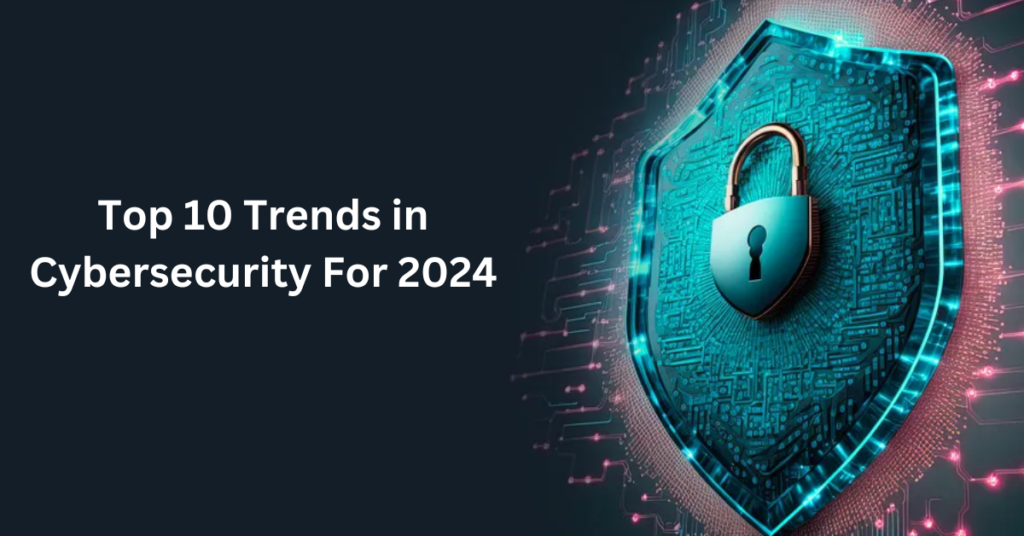
Top 10 Trends in Cybersecurity For 2024
Reading Time: 3 minutesThe field of cybersecurity is about to undergo revolutionary shifts as 2024 approaches. Traditional security paradigms are being challenged by the increasing sophistication and frequency of cyber threats. Recognizing the future trends in this ever changing digital ecosystem is both a matter of foresight and preparation.
Predicting specific trends for a future year like 2024 can be challenging, as the landscape of cybersecurity evolves rapidly and unpredictably. However, based on ongoing developments and current trajectories in technology and security, here are ten potential trends that could shape cybersecurity in 2024:
- AI-Powered Attacks and Defenses: As artificial intelligence (AI) and machine learning (ML) technologies continue to advance, both cyber attackers and defenders are likely to leverage AI algorithms to automate attacks and enhance security measures respectively. This could lead to a new era of AI-driven cyber warfare.
- Quantum Computing and Post-Quantum Cryptography: With the potential advent of practical quantum computers, traditional cryptographic methods could become vulnerable to attacks. Post-quantum cryptography research and implementation will be critical to securing sensitive data against future quantum threats.
- Rise of IoT Security Concerns: As the Internet of Things (IoT) ecosystem grows and becomes more interconnected, the attack surface for cyber threats expands. Ensuring robust security measures for IoT devices and networks will be crucial to prevent large-scale cyber attacks exploiting vulnerabilities in connected devices.
- Zero Trust Architecture Adoption: With the increasing sophistication of cyber threats, organizations are likely to adopt Zero Trust Architecture (ZTA) principles, which assume no trust in users, devices, or networks, and require continuous verification of identity and access rights.
- Cybersecurity Regulation and Compliance: Governments and regulatory bodies are expected to introduce stricter cybersecurity regulations and compliance requirements in response to the rising frequency and impact of cyber attacks. This could include mandatory breach disclosure laws and industry-specific cybersecurity standards.
- Biometric Authentication and Behavioral Analytics: Biometric authentication methods such as facial recognition and fingerprint scanning, coupled with behavioral analytics, will become more prevalent for enhancing identity verification and access control, particularly in industries handling sensitive data.
- Cloud Security Evolution: As organizations increasingly migrate their operations to the cloud, securing cloud environments will become paramount. This entails robust cloud-native security solutions, including encryption, identity and access management (IAM), and cloud workload protection platforms (CWPP).
- Supply Chain Cybersecurity Focus: Cyber attacks targeting supply chains and third-party vendors are likely to rise, posing significant risks to organizations. Strengthening supply chain cybersecurity through vendor risk management and secure software development practices will be essential.
- Cybersecurity Skills Gap Mitigation: The shortage of skilled cybersecurity professionals is expected to persist, prompting organizations to invest in workforce development initiatives, automation technologies, and outsourced security services to bridge the skills gap.
- Emphasis on Privacy and Data Protection: With increasing public awareness and regulatory scrutiny surrounding data privacy, organizations will prioritize robust data protection measures, including encryption, data anonymization, and compliance with privacy regulations such as GDPR and CCPA.
These trends represent potential directions in which cybersecurity may evolve by 2024, driven by technological advancements, regulatory changes, and evolving threat landscapes. However, it’s essential to adapt and remain agile in responding to emerging cyber threats and challenges as they unfold.
Organizations are expected to adopt Zero Trust Architecture principles, strengthen cloud security measures, and prioritize supply chain cybersecurity to mitigate evolving threats. Additionally, there will be a growing emphasis on biometric authentication, behavioral analytics, and data protection to address privacy concerns and regulatory requirements.
Addressing the cybersecurity skills gap through workforce development initiatives and leveraging automation technologies will be essential for organizations to effectively combat cyber threats. Overall, organizations must remain agile and proactive in adapting to emerging cybersecurity trends and evolving threat landscapes to safeguard their assets and maintain trust in an increasingly digital world.